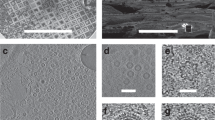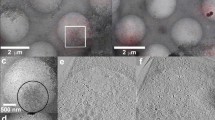Abstract
DARK-GROUND illumination has been used to examine the elementary bodies of large viruses in stained and unstained preparations1,2. We find that unstained crude suspensions of chick embryo yolk sacs infected with the viruses of trachoma and inclusion blennorrhœa, examined under dark-ground illumination, contain particulate host material which obscures the virus particles and which can be confused with them. However, when such suspensions are dried, fixed and stained with Giemsa, many bright yellow-green particles are seen by dark-ground illumination, resembling elementary bodies stained with acridine orange and viewed by ultra-violet microscopy. Their colour and intensity clearly distinguish them from background material, even if they are enveloped by it. They resemble virus particles in size and shape, and their distribution in yolk sac smears is the same as that of the purple elementary bodies in films stained by Giemsa viewed by ordinary illumination; they are not present in smears of normal yolk sacs. Our conclusion that these are virus particles is also supported by dark ground microscopy of inclusions found in HeLa cells infected with trachoma or inclusion blennorrhœa viruses3. The inclusions contain numerous yellow-green particles similar to those in yolk sac smears and suspensions. Large forms of virus are also recognizable, but are much less bright, and reddish in colour.
This is a preview of subscription content, access via your institution
Access options
Subscribe to this journal
Receive 51 print issues and online access
$199.00 per year
only $3.90 per issue
Buy this article
- Purchase on Springer Link
- Instant access to full article PDF
Prices may be subject to local taxes which are calculated during checkout
Similar content being viewed by others
References
Parker, R. F., and Rivers, T. M., J. Exp. Med., 67, 439 (1938).
van Rooyen, C. E., Zent. Bakt. I. Orig., 139, 130 (1937).
Furness, G., Graham, D. M., Reeve, P., and Collier, L. H., Rev. Int. Trachome, 4, 574 (1960).
Dulbecco, R., and Vogt, M., J. Exp. Med., 99, 2 (1954).
Hanna, L., Jawetz, E., Thygeson, P., and Dawson, C., Proc. Soc. Exp. Biol. Med., 104, 142 (1960).
Murray, E. S., Bell, Jr., S. D., Hanna, A. T., Nichols, R. L., and Snyder, J. C., Amer. J. Trop. Med. and Hyg., 9, 116 (1960).
T'ang, F. F., Chang, H. L., Huang, Y. T., and Wang, K. C., Chin. Med. J., 75, 429 (1957).
Jones, B. R., Collier, L. H., and Smith, C. H., Lancet, i, 902 (1959).
Author information
Authors and Affiliations
Rights and permissions
About this article
Cite this article
REEVE, P., TAVERNE, J. A Simple Method for Total Particle Counts of Trachoma and Inclusion Blennorrhœa Viruses. Nature 195, 923–924 (1962). https://doi.org/10.1038/195923a0
Issue Date:
DOI: https://doi.org/10.1038/195923a0
This article is cited by
-
Cell-mediated immune responses to chlamydial antigens in guinea pigs injected with inactivated chlamydiae
Medical Microbiology and Immunology (1980)
Comments
By submitting a comment you agree to abide by our Terms and Community Guidelines. If you find something abusive or that does not comply with our terms or guidelines please flag it as inappropriate.



